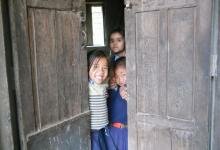This Story Is Not for the Faint-Hearted.
Two teenage boys lynched to death and then hung upside-down in public. Just what does this say about the state of Pakistan?
It was August 15, the day after the country’s 63rd birthday, a day already mired in misery as hundreds of thousands of Pakistanis roamed the land in search of dry ground. In the midst of this, another tragedy unfolded in Sialkot, whose brutality seemed unparalleled even in the shadow of such pre-existing despair.
Two teenage brothers were beaten to death by a lynch mob and their bodies hung upside-down in public. (See news report below)
The story of the two brothers, Hafiz Mughees and Hafiz Muneeb, the image of their bloodied, beaten and bruised dead bodies; the tragic symbols of a nation’s mutilated conscience.
The aftermath of the killings has followed the expected pretences, the same cabal of leaders expressing their outrage, the same media frenzy posturing as debate and the same groups of beaten-down human rights advocates calling attention to the breakdown of law and order in the country.
In its cruel clarity, the recorded scenes of the tragedy present a complete indictment. Everyone is complicit: the ordinary citizen, the corrupt police officer, the man wielding the baton, another hoisting the corpse, those that kicked, those that falsely accused and those that used their hands to press a record button instead of stopping a massacre.
a raped nurse on the street, two brothers executed in broad daylight for alleged blasphemy, a toddler tortured, mutilated and then left in a dumpster – all following the same cyclical path that leads to nothing.
Yet these are all details, the same onerous meaningless blather that follows in the footsteps of every new episode of brutality that the Pakistani public consumes, deplores and then forgets with alarming frequency. The pages of the newspaper themselves testify to the unending cycle of brutality and forgetfulness: a raped nurse on the street, two brothers executed in broad daylight for alleged blasphemy, a toddler tortured, mutilated and then left in a dumpster – all following the same cyclical path that leads to nothing.
Together, these acts form the backdrop of the Sialkot lynching, reiterating that the barbarism of the killings is not an aberration but an emerging norm that dictates mob violence as a legitimate form of self-help.
The outrage affected by officials and media personnel is thus focused not on the idea that such an act is never justified as a means of punishing a criminal but instead on the fact that those punished by the bloodthirsty crowd were actually innocent. The social consensus thus is clear: torture, mutilation and avenging hordes are all legitimate if directed at the correct target.
In a lawful society, violence is the dominion of the state, which has a monopoly on criminal punishment. The grotesque events of Sialkot demonstrate in their agony the utter breakdown of these mechanisms of law and legality in Pakistan.
The blurring of boundaries between an unruly mob and police officials that were both accomplices and onlookers demonstrate this very evisceration. The entire episode represents in actuality the status of the rule of law in the country. Those believed to be guilty are punished: a crowd avenging its own helplessness against random violence and catastrophe overtakes the bodies of killed youth.
The control over prostrated begging boys, the unbridled blows and kicks that eventually kill, represent not simply cruelty and but in an evil paradox also the empowerment of a crowd that feels otherwise poor and powerless. The individual conscience of the perpetrators in the mob is dulled by the collective righteousness of doing what is believed to be right. Mob justice happens when the rule of law has been eliminated and until this is recognised, the suspension of one official or another is but a charade.
In a society where the mob is king, weakness is a liability.
In a society where the mob is king, weakness is a liability. It is this Hobbesian reality that is so graphically captured by the events in Sialkot. The national narrative has become such that catastrophe and even poverty are considered a sign of moral weakness and divine punishment. This extends not merely to those who can be persecuted by collective hoards but also on those whom natural catastrophe has heaped tragedy.

In the aftermath of the flood, Pakistani television screens have been replete with clerics invoking not sympathy but alleging that the suffering victims are somehow cursed, their tragedy divine punishment for moral transgressions, appearing in the form of a natural disaster. It is this disdain for weakness that is indicative of the ruthless survivalism of a new heartless Pakistan where the equation of life boils down to the maxim that if you do not vanquish you will indeed be vanquished.
The rule of law and independence of the judiciary has in the past few years been central to politics in Pakistan, instrumental in the return of ex-prime ministers, the current presidency and a cornucopia of other political conglomerations that occupy the helm of the country.
In a cruel irony, as the country celebrated the reinstatement of Chief Justice Iftikhar Chaudhry as a symbolic return to law, the actual workings of the judiciary in terms of the provision of law and order were all reduced to a political project. The justice of suo moto notices where courts select politically expedient issues has highlighted the utter de-legitimisation of a legal system that has not delivered any justice for decades.
Sialkot then should not be a surprise. With institutional justice so utterly destroyed, and courts a show apparently to justify the government salaries of various functionaries, mob justice is inevitable. While the rich can continue to indulge the fantasy that something might actually be done if their cars are snatched at gunpoint or their homes invaded, the poor inhabit a cruder reality where brutal revenge, publicly exacted, is seen as the only deterrent to being divested of house and home.
Understanding that the Sialkot lynching represents a new social and legal reality is not meant to either excuse or justify its barbarity, but rather to highlight the fact that such acts of brutal revenge represent not the exception but the norm in Pakistan.

















